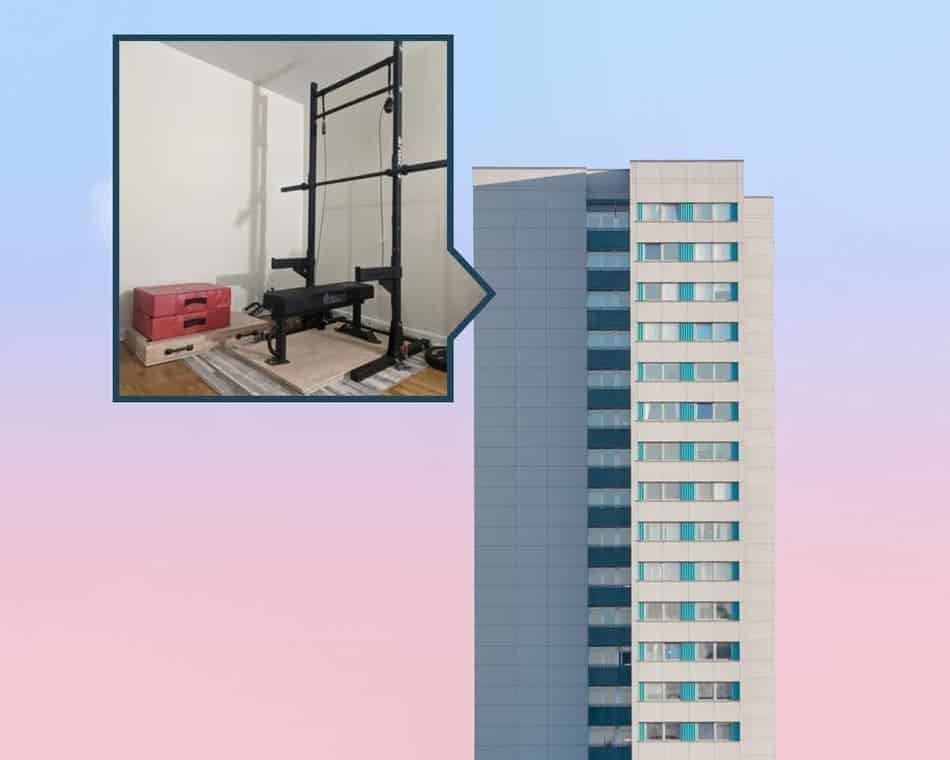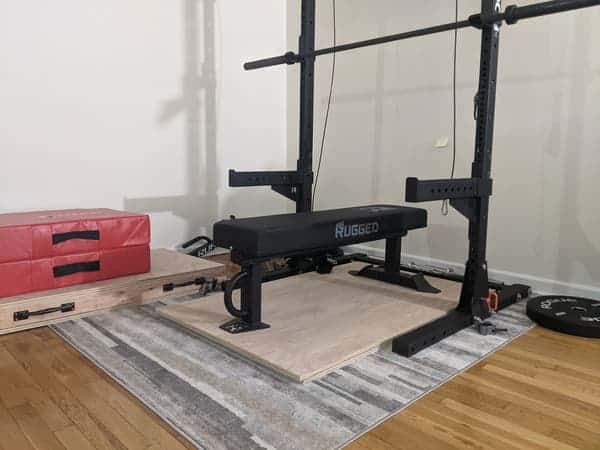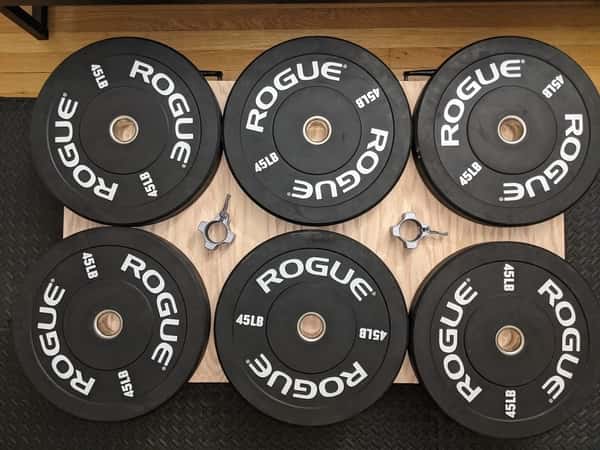This post contains affiliate links.

When I first started my home gym in my 5th-floor apartment, I was anxious that I would fall through the floor while squatting or deadlifting. Fast forward to almost one year later, I have complete peace of mind squatting and deadlifting 400+ pounds on a regular basis. I have not had any noise complaints from my neighbors either!
So can you build a home gym upstairs? You can definitely build a home gym and lift heavy upstairs in most situations with two big considerations.
- The building structure can safely handle the weight of a home gym.
- Use carpets, mats, drop pads, and bumper plates to reduce noise in the home gym.
Keep reading to learn how to assess your space so you can build a safe and quiet home gym.
Table of Contents
Is it safe to build a home gym upstairs?
The fundamental concept to understand when it comes to safety is live loads. To put it simply, the live load is the total weight of objects that may move inside a building or room. For a home gym, the live load would be the total weight of you and your gym equipment.
In the US, residential buildings must support a uniform live load of 30 pounds per square foot (40 psf for apartments) and a concentrated live load of 200 pounds per 4 square inches. What this means is your room will be able to support the weight of you and your home gym equipment if it’s within the uniformly distributed and concentrated live loads ratings. Keep in mind that these ratings are conservative. Realistically, they can probably support more.
Now let’s use some examples to interpret the live load charts provided by the city of New York.
Uniformly Distributed Live Loads
| Dwelling | Space | Live Load (psf) |
| Multi-family units | Apartments | 40 |
| One- and two-family units | First floor | 40 |
| One- and two-family units | Upper floors and habitable attics | 30 |
| One- and two-family units | Uninhabitable attics | 20 |
Let’s say you have a room that is 10 feet x 10 feet. That means the room is 100 square feet.
Multiplying the square footage by uniformly distributed live load rating will give you the uniformly distributed live load.
100 square feet x 30 psf is 3,000 pounds!
Your home gym, along with other furniture, and people must not exceed 3,000 pounds.
Concentrated Live Loads
| Location | Load (lbs) | Remarks |
| Resident and multiple dwellings | 200 (on area of 4.0 sq. in.) | Nonconcurrent with uniform live load. |
When you’re lifting heavy weight, the weight will be concentrated under your feet. If your foot is 10 inches long and 3 inches wide, then each foot will be 30 square inches (60 total for two feet).
If an area of 4 square inches can support 200 pounds, 30 square inches can support 7.5 times of 200 pounds, which is 1,500 pounds!
That means your floor can support 1,500 pounds if all that weight is under one of your feet.
Don’t feel assured yet? Think about this. Would you be worried if two overweight people (300lbs each) stood closely together in your room? I don’t think so!
When in doubt, consult a professional.
How do you reduce noise in a home gym?
Another point to consider when building a home gym upstairs or in an apartment is noise from clanking weights. Luckily, there are several things you can do so you don’t get a complaint from your neighbor or downstairs family members.
1. Use Carpet or Mat

One suggestion is to cover your workout area with carpet or foam mats. The floor covering helps noise and vibration reduction for both lifting weights and treadmills.
Although many people suggest rubber horse stall mats, I wasn’t a fan of them. The rubber horse stall mats release compounds that are potentially harmful to your health. The rubber mats emit a strong odor and cause headaches for some after being around them. I drove to a Tractor Supply store and had to resell it after giving them a try in my apartment. The ideal space for rubber horse stall mats is a well-ventilated area like an outdoor gym or a garage gym with open doors.
2. Use Silencer Pads
My favorite solution to keeping my deadlifts quiet is using silencer pads. These are amazing in reducing noise. I deadlift 400+ lbs without much noise. That being said, I still put down the weight lightly to further reduce noise.
The drop pads that we use are these Titan Silencer Drop Pads: https://titan-fitness.pxf.io/9Wma7j
3. Use Bumper Plates

If you’re doing barbell training that involves lowering the weight to the floor, such as deadlifting, I would strongly recommend bumper plates. Bumper plates are quieter than metal plates, although they are more expensive.
Check out the buying guide for barbell plates for the top picks of bumper plates.
4. Rack Weights Quietly
Racking your weight can be another source of loud noises so a final suggestion that requires no additional cost is racking your weight slowly and quietly.
Related Questions
How can I build a home gym in a small apartment?
You can build a minimalist home gym that doesn’t require much space by choosing compact equipment that can be stored away when not in use. Examples include a kettlebell, yoga mat, jump rope, or dumbbells.
Is a weightlifting or deadlift platform necessary?
For most people, a platform is not necessary. Just having a carpet or a mat will prevent scratches from your weights. However, if you’re lifting over 300 lbs, you may want to consider a platform. I personally prefer a platform of plywood because it provides more stability to my lifts and absorbs some of the impact.
HomeStrengthToolbox.com is a participant in the Amazon Services LLC Associates Program, an affiliate advertising program designed to provide a means for sites to earn advertising fees by advertising and linking to Amazon.com. We also participate in other affiliate programs which compensate us for referring traffic at no extra cost to you.
